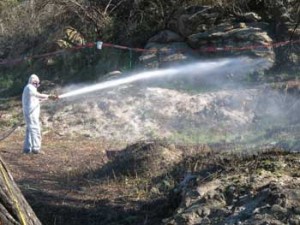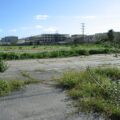Citizen-inspired remediation starts at lab-adjacent Sage Ranch
By Michael Collins
Ventura County Reporter – November 21, 2007
 The Boeing workers in the otherworldly suits looked out of place trudging through the dry creek bed that separates Sage Ranch Park and the Santa Susana Field Laboratory Nov. 20. Outfitted in head-to-toe translucent plastic uniforms with air filter masks, goggles and gloves, they chain-sawed a swath through the brush and trees blocking the seasonal stream. As they worked, their quarry appeared: black and grey blocks of lung-destroying asbestos and broken pipes with the toxic heavy metal antimony.
The Boeing workers in the otherworldly suits looked out of place trudging through the dry creek bed that separates Sage Ranch Park and the Santa Susana Field Laboratory Nov. 20. Outfitted in head-to-toe translucent plastic uniforms with air filter masks, goggles and gloves, they chain-sawed a swath through the brush and trees blocking the seasonal stream. As they worked, their quarry appeared: black and grey blocks of lung-destroying asbestos and broken pipes with the toxic heavy metal antimony.
All the while, a worker used a high pressure hose to spray down the area to keep the lung-destroying asbestos from becoming airborne.
Work began Nov. 9 on what will be a massive cleanup in the hills near Simi Valley in eastern Ventura County. The remediation began after the state’s Department of Toxic Substances Control (DTSC) issued lab owners Boeing and the NASA an Imminent and Substantial Endangerment Order on Nov. 1 for the cleanup of asbestos-containing material strewn along the creek bed from 1965 to 1978 by lab workers working at the former NASA liquid oxygen plant (LOX) nearby. The order also requires cleanup of the Rocketdyne-Atomics International Rifle and Pistol Club shooting range where elevated concentrations of polyaromatic hydrocarbons (PAHs) have been found in the soil near and down stream of the former shooting range.
The deadly debris stretches partway down the intermittent headwaters of the so-called Northern Drainage, which leads into the American Jewish University on Brandeis-Bardin’s sprawling campus in Simi Valley below. The 2005 Topanga Fire, which swept through the area and burned much of the 2,850-acre lab, also revealed the detritus of decades of Cold War work on “The Hill,” as it is called today by environmental activists whose aim to make sure the property is cleaned up is suddenly, and surprisingly, seeing fruition.
Christina Walsh, William Preston Bowling, and John Luker are three of those activists and have the distinction of being some of the most prolific on-site observers of the bucolic range of hills cursed by Rocketdyne’s chemical and radiological contamination. Last March, they were hiking along the Sage Ranch Loop Trail when they spotted the first blocks and layers of what turned out to be lethal asbestos insulation from where nearby the LOX was situated before being demolished.
“[The debris was] bigger than Bill,” Walsh said of the first asbestos find. “It was the entire wall of the creek, and when we scraped the wall, it was pure white underneath. Very unnatural, that was clear, but we really didn’t know what it could be.”
“It looked like a slice of three-layer cake, yet full of foam, pipes and powder,” said Bowling, who covers the contentious Rocketdyne issue for his website h2ohno.com. “We invited the DTSC on a hike of Sage Ranch to show them our concerns.”
To the amazement of the trio, after years of being at loggerheads with the government and Boeing over cleaning up the intensely polluted site, the DTSC responded.
“After studying the photographs we had, we went back and looked again,” said Walsh, whose website CleanUpRocketdyne.org is chronicling the Sage Ranch remediation. “We put together a PowerPoint and sent it to [DTSC’s] Norm Riley in an email. We offered to show him in person and he took us up on our offer. He showed up with his entire team.”
Riley is the DTSC’s lead man overseeing the clean-up of the creek and, beginning Jan. 1, will also head the state’s supervision of the historic decontamination of the former Rocketdyne facility, conducted and paid for by Boeing before the aerospace and defense contractor donates the site to the state as open space never to be developed (See: “Dirty Business,” Feature, 11/1/07). It was clear to the DTSC team that there was something amiss when they inspected the site with the environmentalists June 15.
“Well, it’s not a natural material, which is to say that it doesn’t fit in with the landscape there,” Riley told the Reporter. “It’s sort of a light gray-colored material, by and large. There are some bits and pieces of various things sticking out of it, pieces of metal and so on. It’s clearly not natural material. You could just tell at a glance that it didn’t belong there. It wasn’t native soil.”
The LOX debris field contamination includes asbestos, silica and antimony. Small amounts of antimony cause dizziness, headache and depression and greater doses can lead to death after several days of frequent and violent vomiting. This area will have approximately 500 cubic yards of the tainted soil trucked offsite to a licensed landfill. 8,000 cubic yards of soil polluted by PAHs will be excavated as well from the former shooting range and along the Northern Drainage. The work will require approximately 764 truckloads which will be covered and cleaned of tire soil and debris before leaving the cleanup site.
In the decades-long dispute over the polluted lab and the impacted surrounding areas, what is most striking is the swiftness and scope of the Sage Ranch cleanup.
“We are making that a high priority here at the Santa Susana Field Lab because we are well aware of concerns that members of the surrounding communities have,” Riley said. “I think that over the last several months in particular, our relationship with the community, their trust in us, has improved considerably because they do see that we have their interests in mind and that we are doing our best to be responsive to their concerns.”
27 Years of Award-Winning SSFL/Rocketdyne Reporting
1998 – 2025












Recent Comments